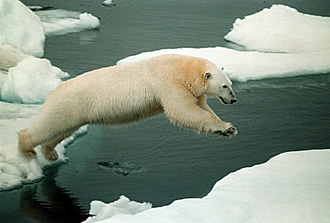
|
 |
 |
 Editorials | Environmental | March 2008 Editorials | Environmental | March 2008  
Study Warns: Arctic Ocean – From Thick Ice To Endless Pool
 Dee Chisamera - eFluxMedia Dee Chisamera - eFluxMedia
go to original


| | (Greenpeace/Daniel Beltrá) | | |
The effects of global warming have already begun to manifest, scientists warned at a NASA conference. Following satellite observations, they reported two simultaneous situations, one on short term and the other one on long term.

The Arctic region is dealing with an increase in the sea ice this year, due to weather conditions, but at the same time, perennial sea ice continues to shrink, which is a clear effect that global warming has already started to set in.

NASA’s observations concluded that the perennial ice now covers only 30 percent of the Arctic, compared to the 50-60 percent it used to cover in the past. Compared to two centuries ago, the oldest sheet of ice that used to cover 20 percent of the Arctic and lasted for about 6 years now covers only 6 percent of the Arctic.

Walt Meier of the National Snow and Ice Data Center at the University of Colorado, Boulder said normally, as years pass, ice should get thicker and grow in size. This time however, as the ice sheet continued to get thinner during winter, it is very likely that it will get even thinner once the summer season starts.

According to NASA’s Aqua satellite and NOAA, as well as U.S. Defense Department’s satellites, the ice extent over the Arctic significantly increased 3.9 percents from its March maximum of 5.9 million square miles compared to the last three years, due to lower temperatures on the surface than usual, but overall, it has reached an all-time minimum.

The fact that this winter was cold and the ice sheet slightly increased is not a sign that things are going in the right direction, and the best proof for that is the perennial ice, that is getting thicker. The summer season will bring even more changes, as the thin sheet of ice that resulted this summer will melt, and scientists expect loses from the perennial ice too.

We have to make a clear distinction between the short-term effects, that show an improvement in ice level, but not as a lasting phenomenon, and the long-term effects of temperatures rising, that contribute to an Arctic meltdown. | 
 | |
 |



